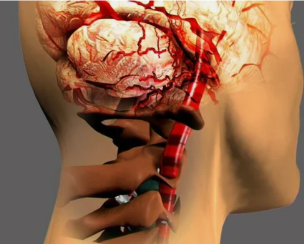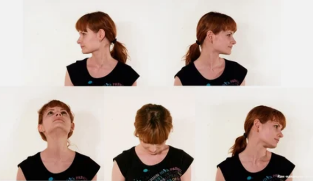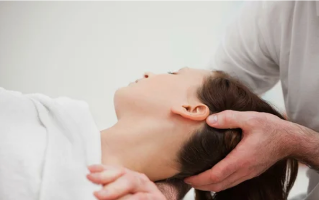
Cervical osteochondrosis is a disease in which the pulp between the vertebrae, acting as a shock absorber, becomes stiff cloth.
Pain in the neck? Dizziness? Crunch? Neck backache? "Do low back pain..." you think, typing a query in the Internet. No need to panic! Osteochondrosis of the cervical spine is not a death sentence, it can be prevented, slowed and even cured. How? Let's deal with it.
Introduction
Unfortunately, cervical osteochondrosis – a disease of the quiet and insidious. You may not be aware of its existence, until at some point will not experience muscle spasm and pain in the neck. Often there are added dizziness and numbness of extremities.
The reason for these seemingly unrelated phenomena in the complex nature of osteoarthritis.
What is the osteochondrosis from General...
Osteochondrosis is a disease of the spine, which are damaged intervertebral disks performing as shock absorbers. Opening and closing, they give the spine flexibility and elasticity, while allowing the body to maintain balance during the movement. In their partial or total destruction of this balance is lost, which inevitably affects the motor activity of man. The reason for these changes is often physical deterioration and deformation of the disk or, more simply, its "ageing". The other part of our body can serve us faithfully for many years.
It is accepted that osteochondrosis – a disease of age. However, recent years the disease is much "younger" in the risk zone are people 25 years or younger. Blame sedentary lifestyle, unhealthy diet and irregular physical activity on the body. Moreover, statistics show that osteochondrosis often affects women. Primarily, this is due to the anatomical features and emotional background. However, the harder the disease occurs in men.
...to the private – cervical osteochondrosis
Osteochondrosis of the cervical spine is the most common. The fact that it is in the neck the majority of vessels and nerve endings, while the vertebrae themselves are much smaller (approximately half compared with the lumbar spine) and muscular system significantly weaker.
Coupled with high mobility and the proximity of the spinal cord cervical of our body requires special attention.
How dangerous is cervical osteochondrosis?

Alas, the danger of cervical degenerative disc disease is anatomically justified through the cervical spine are the vertebral arteries, which provide blood to an important brain centers in the posterior portions of the brain. And any failure and circulatory disorders can be irreversible in nature, from the abnormal curvature of the spine (lordosis of the neck) until the complete loss of motor skills, stroke, and even death.
Fortunately, you do not notice the symptoms of impending catastrophe is almost impossible: problems with coordination, severe impairment of vision and hearing, frequent dizziness and loss of consciousness...
If coupled with regular neck pain you notice these symptoms, immediately consult a doctor!
Diagnosis and symptoms of cervical osteochondrosis
Low back pain is a serious disease, and diagnose it only by a qualified specialist, the doctor-vertebrologist, specializing in solving problems with the spine, orthopedist or neurologist.
The most accurate methods of diagnosis of cervical degenerative disc disease: x-rays, computed tomography (CT) and magnetic nuclear resonance (MRI), which allows to identify not only the symptoms of cervical-thoracic osteochondrosis, and other related changes in the body.
With the emergence of a number of listed symptoms, immediately seek the professional advice of a physician.
- dull, aching, intense pain in the neck and head
- neck backache, the crunch when you turn your head
- dizziness, the "veil" before the eyes, fainting
- headache
- nausea, vomiting
- numbness
- noise in the ears, blurred vision
- General muscle weakness
Pain in osteochondrosis are often aching in nature, is given in the head and are accompanied by numbness of the hands and feet. This is primarily due to pinched nerve endings and increased intracranial pressure.
The nature of osteochondrosis
Just like any disease, osteochondrosis of the spine has several stages of development.
For a better understanding of the body processes we offer to first understand the structure of the disk, and then to analyze, what changes are characteristic for each stage of degenerative disc disease.
He vertebral disk consists of several parts: pulpous nucleus pulposus (the inner part), annulus fibrosus (the outer shell) and hyaline cartilage that separates the disc from the vertebrae and performing the function of supply.
Purposee the core is rich in water, and it is responsible for depreciation, adjusting to the center of gravity, salivas and moving like a mercury ball. The surrounding fibrous ring, on the contrary, has a solid structure and consists of interwoven fibers. Since the main task of the fibrous ring – to protect the core from damage, it takes a "blow" on itself at high loads.
Stages of degenerative disc disease
Traditionally there are four stages of osteoarthritis.
Cervical osteochondrosis of 1 degree – preclinical stage
This early stage of the disease, occurs when the so-called "drying" of the disk: its reduced height and firmness.
Thus structural changes do not, however, as symptoms and, therefore, no complaints. You may not feel discomfort; the only "precursors" may be morning stiffness and salt deposits in the neck. Although agree with our way of life these feelings are the norm.
Cervical osteochondrosis of 2 degrees – the beginning of structural changes
Here begin irreversible changes in polipozom core – necrosis and destruction caused by metabolic disturbances, simultaneously with the formation of cracks in the fibrous ring.
The body starts to send SOS signals in the form of a sharp pain in the neck, reduced stamina, rapid fatigue.
Cervical osteochondrosis 3 degree – progressive of discos
Impaired integrity of the fibrous ring, resulting in purposee core "bulges" into the spinal canal through the cracks.
If a complete rupture of the outer shell occurs, the intervertebral disk can be restored. This process is called disc protrusion of the spine and can be treated successfully in the outpatient setting. At the same time you feel persistent pain in the neck and all over your back, progressing during exercise and stay in an uncomfortable position.
In the case of complete destruction of the fibrous ring to the added pain problems with coordination, dizziness, nausea; the risk of disability. Need to quickly seek medical help!
Cervical osteochondrosis 4 degrees – regeneration
In the result of irreversible processes between the vertebrae are formed outgrowths (osteophytes) that blocks the mobility of the joints. Purposee the kernel is replaced by scar tissue, nerve endings are injured, recovery is possible only surgically.
Paradoxically, in terms of health you can feel a noticeable improvement – the spine regains its ability to accept load. However, pain and limited physical activity later will only increase.
The causes of osteochondrosis

Alas, speaking about the reasons of such difficult diseases as osteochondrosis, it is necessary to bear in mind numerous factors from the external environment to the natural predisposition.
How to understand that you are at risk? Mentally tick each of the items suitable for you and your lifestyle.
- Have you had a spinal injury?
- Are overweight (obesity rates)?
- Exposed to harmful habits (Smoking, alcohol consumption), regular stress?
- You suffer from chronic infectious diseases, metabolic disorders?
- Your work involves heavy physical labor?
- Have you been diagnosed with posture disorder and/or flat feet?
- Do you have a regular load on the spine?
If at least one of the questions you answered in the affirmative, alas, you are at risk. This is bad news. But there is good: osteochondrosis of the cervical spine can be stopped, cured and even prevented with timely diagnosis and beginning of proper prevention.
How to prevent low back pain
There are a number of preventive measures we recommend to respect for the game "ahead of the curve" with osteochondrosis of the cervical spine.
Step 1. Stand up!
Lead a sedentary lifestyle? Sedentary work, long periods at the computer, irregular and improper diet, lack of sleep, stress... sound Familiar?
All this contributes to a "stagnant" processes in the body and provokes the initial stage of osteoarthritis.
To avoid the progression of the disease, maintain a sensible schedule of the day, take regular breaks (every hour for five minutes) and care more about their health. Believe me, very soon you yourself will say "thank you"!
The rule is: set reminders (or "running" cases – the alarm clock) so that your excitement not to miss a moment... when you just need to get up and walk.
Step 2. Take care of your own convenience!
Under usability we mean the physical signals that the body takes. Listen and take care of yourself!
First, avoid excessive and unreasonable workloads. If you are hitting the gym, batch weight, do not skip the warm up and watch for regular training.
Secondly, refrain from uncomfortable shoes. We do not call relentlessly to get rid of your favorite weekend shoes or boots, let them stay for special occasions. It is important that these special cases do not become your norm 24/7. "Every day" choose shoes with a comfortable fit that does not cause discomfort and does not affect posture and gait.
Thirdly, do not skimp on the furniture and sleeping accessories. If office chair you are expressly not suitable, please arrange a replacement or take care of their comfort themselves. Subsequently, this one-time investment can save you from serious regular expenses.
Only use anatomically correct furniture, reducing the load on the spine. For home, choose a bed with a firm mattress and comfortable, suitable density and height of the pillow. Anatomical or conventional – you decide, since a lot depends on characteristics of your body.
Step 3. Do not forget about prevention!
Forewarned is forearmed, isn't it?
If you feel occasional fatigue and pain in the neck and back or, on the contrary, want to avoid them, we suggest a simple set of exercises, especially effective in the initial (preclinical) stages of osteoarthritis.
Exercises with cervical osteochondrosis

Gymnastics in osteochondrosis of the cervical you can perform both at home and on the job.
- Sit up straight, straighten your back, relax your hand and push along the body. Alternately rotate the head left and right, approximately 90 degrees (or as permitted by the joints). Move smoothly, avoid sudden movements.
First time do for 8 repetitions and then gradually increase the number of turns to 15 in each direction. - In the same position tilt your head forward, tucking your chin to your chest and back, pushing the back of the head to the back of the neck. Also start with 8 repetitions and increase up to 15 times.
- Then go to the shoulders. First, raise both shoulders up (toward the ears), hold for a few seconds and lower back. So 8 repetitions.
Then move the shoulders in turn: right-up, left-down, change – of 8 repetitions. - Put hand on forehead and apply pressure with simultaneous tilt of the head forward. Pause for 10 seconds and so on 8 times in a row.
After the end of the complex, be sure to massage the neck to relieve the tension.
Attention! If you feel severe discomfort during exercise, consult your doctor and carefully take the load!
Cervical osteochondrosis: treatment
Treatment of degenerative disc disease of the cervical spine can be narrowly focused or comprehensive, combining multiple components at once.
Physical therapy

Physical therapy with cervical osteochondrosis is a way local effect directly on the inflammation. The therapeutic effect is achieved by improving circulation and metabolic processes. Neck pain is relieved, the symptoms reduced.
There are many options for physical therapy in cervical-thoracic osteochondrosis: electrotherapy, the effect of magnet, laser, water and mud procedures, electrophoresis, acupuncture, and a moderate warming of the inflamed area.
Before you sign up for the procedure, carefully review the contraindications, and consult your physician.
Massage
With cervical osteochondrosis helps massage the neck area. You can sign up for a session to a massage therapist or massage yourself with expert vibro.
Medications and diet
Among the most commonly used osteoarthritis medications are anti-inflammatory agents, analgesics, antispasmodics, antioxidants, and medications to improve blood circulation and metabolic processes. Range of medicines includes tablets, creams, ointments and solutions for intramuscular injection.
Remember to correctly choose the drug can only be a doctor!
To increase the effectiveness of drugs and improve overall body tone will help balanced diet. Limit consumption of fatty, spicy, smoked food, salt. Give preference to fruits and vegetables, properly cooked meat, fish and dairy products. Add in the diet of nuts and honey. And drink plenty of fluids.
Even if the degenerative disc disease does not threaten you, balanced diet has a positive impact on General health and the condition of the body. You'll see in a couple of weeks you will notice amazing changes! Tested on their own experience!



































